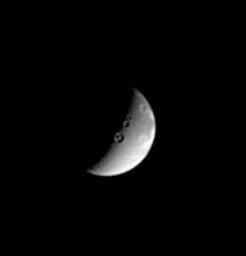
|
Craters ‘Twixt Day and Night
- Click the image above for a larger view
- Full-Res JPEG (397 x 413) (3.6 kB)
- Full-Res TIFF (397 x 413) (26.0 kB)
Caption:
Three sizeable impact craters, including one with a marked central peak, lie along the line that divides day and night on the Saturnian moon, Dione (dee-OH-nee), which is 1,118 kilometers, or 695 miles across. The low angle of the Sun along the terminator, as this dividing line is called, brings details like these craters into sharp relief.
This view shows principally the leading hemisphere of Dione. Some of this moon's bright, wispy streaks can be seen curling around its eastern limb. Cassini imaged the wispy terrain at high resolution during its first Dione flyby on Dec. 14, 2004.
This image was taken in visible light with the Cassini spacecraft narrow angle camera on Nov. 1, 2004, at a distance of 2.4 million kilometers (1.5 million miles) from Dione and at a Sun-Dione-spacecraft, or phase, angle of 106 degrees. North is up. The image scale is 14 kilometers (8.7 miles) per pixel. The image has been magnified by a factor of two and contrast-enhanced to aid visibility of surface features.
Background Info:
The Cassini-Huygens mission is a cooperative project of NASA, the European Space Agency and the Italian Space Agency. The Jet Propulsion Laboratory, a division of the California Institute of Technology in Pasadena, manages the mission for NASA's Science Mission Directorate, Washington, D.C. The Cassini orbiter and its two onboard cameras were designed, developed and assembled at JPL. The imaging team is based at the Space Science Institute, Boulder, Colo.
For more information, about the Cassini-Huygens mission visit, http://saturn.jpl.nasa.gov and the Cassini imaging team home page, http://ciclops.org .
Cataloging Keywords:
| Name | Value | Additional Values |
|---|---|---|
| Target | Dione | |
| System | Saturn | |
| Target Type | Satellite | |
| Mission | Cassini-Huygens | |
| Instrument Host | Cassini Orbiter | |
| Host Type | Orbiter | |
| Instrument | Imaging Science Subsystem (ISS) | |
| Detector | Narrow Angle Camera | |
| Extra Keywords | Crater, Grayscale, Impact, Visual | |
| Acquisition Date | ||
| Release Date | 2004-12-20 | |
| Date in Caption | 2004-11-01 | 2004-12-14 |
| Image Credit | NASA/JPL/Space Science Institute | |
| Source | photojournal.jpl.nasa.gov/catalog/PIA06542 | |
| Identifier | PIA06542 | |
